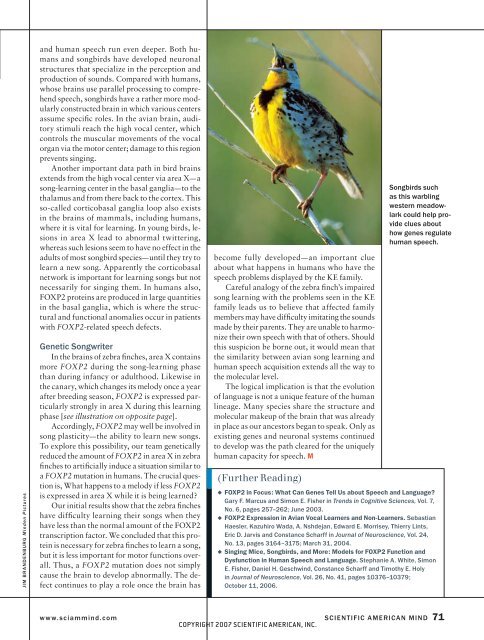Scientific American Mind-June/July 2007
Scientific American Mind-June/July 2007
Scientific American Mind-June/July 2007
You also want an ePaper? Increase the reach of your titles
YUMPU automatically turns print PDFs into web optimized ePapers that Google loves.
JIM BRANDENBURG <strong>Mind</strong>en Pictures<br />
and human speech run even deeper. Both humans<br />
and songbirds have developed neuronal<br />
structures that specialize in the perception and<br />
production of sounds. Compared with humans,<br />
whose brains use parallel processing to comprehend<br />
speech, songbirds have a rather more modularly<br />
constructed brain in which various centers<br />
assume specifi c roles. In the avian brain, auditory<br />
stimuli reach the high vocal center, which<br />
controls the muscular movements of the vocal<br />
organ via the motor center; damage to this region<br />
prevents singing.<br />
Another important data path in bird brains<br />
extends from the high vocal center via area X—a<br />
song-learning center in the basal ganglia—to the<br />
thalamus and from there back to the cortex. This<br />
so-called corticobasal ganglia loop also exists<br />
in the brains of mammals, including humans,<br />
where it is vital for learning. In young birds, lesions<br />
in area X lead to abnormal twittering,<br />
whereas such lesions seem to have no effect in the<br />
adults of most songbird species— until they try to<br />
learn a new song. Apparently the corticobasal<br />
network is important for learning songs but not<br />
necessarily for singing them. In humans also,<br />
FOXP2 proteins are produced in large quantities<br />
in the basal ganglia, which is where the structural<br />
and functional anomalies occur in patients<br />
with FOXP2-related speech defects.<br />
Genetic Songwriter<br />
In the brains of zebra fi nches, area X contains<br />
more FOXP2 during the song-learning phase<br />
than during infancy or adulthood. Likewise in<br />
the canary, which changes its melody once a year<br />
after breeding season, FOXP2 is expressed particularly<br />
strongly in area X during this learning<br />
phase [see illustration on opposite page].<br />
Accordingly, FOXP2 may well be involved in<br />
song plasticity—the ability to learn new songs.<br />
To explore this possibility, our team genetically<br />
reduced the amount of FOXP2 in area X in zebra<br />
fi nches to artifi cially induce a situation similar to<br />
a FOXP2 mutation in humans. The crucial question<br />
is, What happens to a melody if less FOXP2<br />
is expressed in area X while it is being learned?<br />
Our initial results show that the zebra fi nches<br />
have diffi culty learning their songs when they<br />
have less than the normal amount of the FOXP2<br />
transcription factor. We concluded that this protein<br />
is necessary for zebra fi nches to learn a song,<br />
but it is less important for motor functions overall.<br />
Thus, a FOXP2 mutation does not simply<br />
cause the brain to develop abnormally. The defect<br />
continues to play a role once the brain has<br />
become fully developed—an important clue<br />
about what happens in humans who have the<br />
speech problems displayed by the KE family.<br />
Careful analogy of the zebra fi nch’s impaired<br />
song learning with the problems seen in the KE<br />
family leads us to believe that affected family<br />
members may have diffi culty imitating the sounds<br />
made by their parents. They are unable to harmonize<br />
their own speech with that of others. Should<br />
this suspicion be borne out, it would mean that<br />
the similarity between avian song learning and<br />
human speech acquisition extends all the way to<br />
the molecular level.<br />
The logical implication is that the evolution<br />
of language is not a unique feature of the human<br />
lineage. Many species share the structure and<br />
molecular makeup of the brain that was already<br />
in place as our ancestors began to speak. Only as<br />
existing genes and neuronal systems continued<br />
to develop was the path cleared for the uniquely<br />
human capacity for speech. M<br />
(Further Reading)<br />
Songbirds such<br />
as this warbling<br />
western meadowlark<br />
could help provide<br />
clues about<br />
how genes regulate<br />
human speech.<br />
◆ FOXP2 in Focus: What Can Genes Tell Us about Speech and Language?<br />
Gary F. Marcus and Simon E. Fisher in Trends in Cognitive Sciences, Vol. 7,<br />
No. 6, pages 257–262; <strong>June</strong> 2003.<br />
◆ FOXP2 Expression in Avian Vocal Learners and Non-Learners. Sebastian<br />
Haesler, Kazuhiro Wada, A. Nshdejan, Edward E. Morrisey, Thierry Lints,<br />
Eric D. Jarvis and Constance Scharff in Journal of Neuroscience, Vol. 24,<br />
No. 13, pages 3164–3175; March 31, 2004.<br />
◆ Singing Mice, Songbirds, and More: Models for FOXP2 Function and<br />
Dysfunction in Human Speech and Language. Stephanie A. White, Simon<br />
E. Fisher, Daniel H. Geschwind, Constance Scharff and Timothy E. Holy<br />
in Journal of Neuroscience, Vol. 26, No. 41, pages 10376–10379;<br />
October 11, 2006.<br />
www.sciammind.com SCIENTIFIC AMERICAN MIND 71<br />
COPYRIGHT <strong>2007</strong> SCIENTIFIC AMERICAN, INC.

















